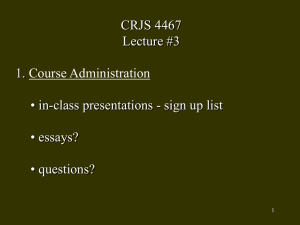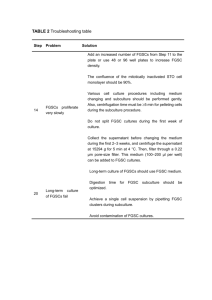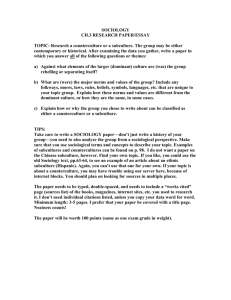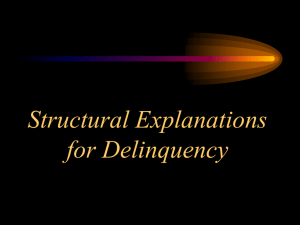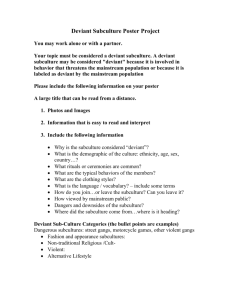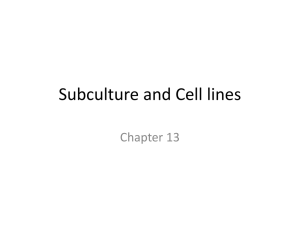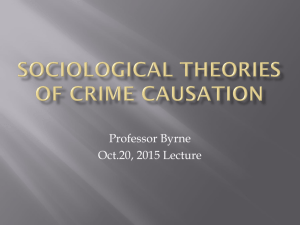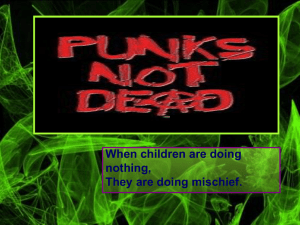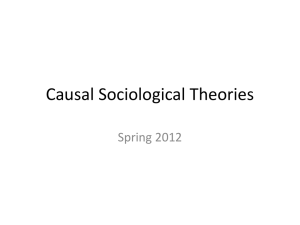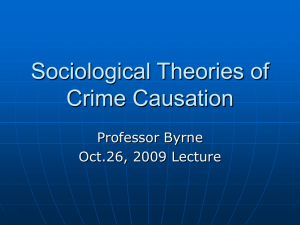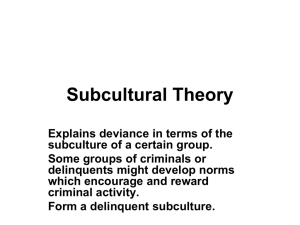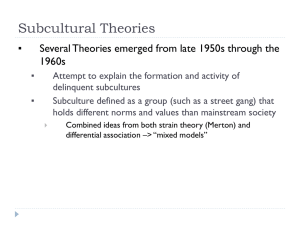Theories of delinquency
advertisement
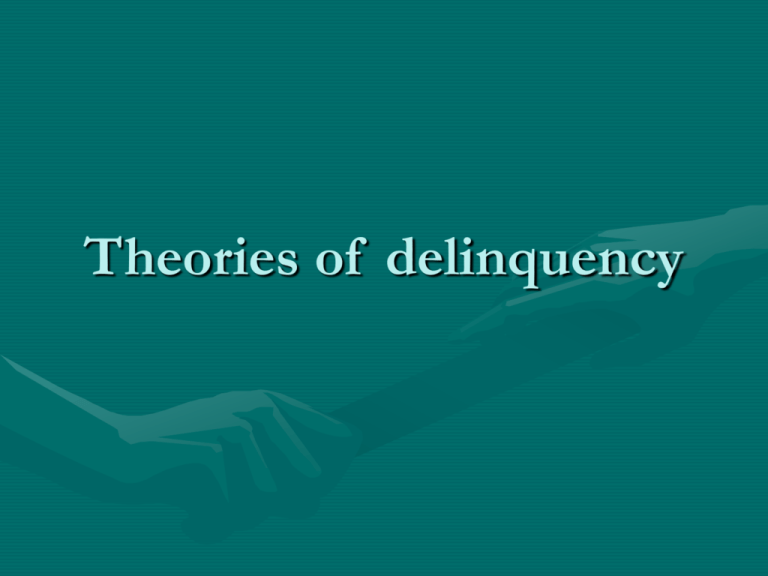
Theories of delinquency Theories • • • • Deterrence Free will, rational choices Swiftness, certainty and severity of punishment Belief in certainty of apprehension the most important factor, most direct relationship • Severity of punishment does not appear to have a direct effect Biological • Morphological: little support, except for mesomorphic body build • Inheritance: some support • Other biological factors: diet, head injuries, EEG findings, birth problems, lead poisoning, hormones • FAS, other drugs, LD, ADHD (prenatal care) Psychological concepts • • • • Psychoanalytic approach Personality (personality disorders) Mental illness Learning theory: reinforcement, findings on punishment (immediacy, consistency, punishing enough without being excessive, alternative behaviors that are reinforced) • Moral development research Social structure • Ecological theory • City zones • Transitional, (interstitial) areas, poverty, cultural heterogeneity, mobility • Criminal and victims tend to live in these areas • Social disorganization theory (alienation, cultural heterogeneity and lack of common value system, less cohesion, less informal control Strain theory • People who cannot achieve societal goals will experience strain • U.S.: emphasis on getting ahead and being materially successful, having money, prestige, power through skill, education and hard work • People react in different ways to this strain • Criminals may try to achieve some measure of material success through crime General strain theory • Individuals who are stressed may commit crimes • Cultural goal of success may apply less to juveniles • Anger, frustration, disappointment, depression and fear generated by negative social relations • Not only economic goals but other noneconomic ones having to do with relationships Consensus • Durkheim and alienation • Normlessness • Difficulty to control society’s members when there is a lack of consensus about appropriate behavior • Increasing lack of consensus in modern, diverse complex societies Subculture theories • Set of norms, values and beliefs different from those of the mainstream culture • When these are at odds with those of the larger culture, members of the subculture and more likely to get into trouble • Example of cults (Waco and Ruby Ridge) • Cohen’s “middle class measuring rod” (education and delaying gratification) Subculture • Status frustration, may rebel and act in opposition to the middle class • Differential opportunity theory • Youths have the goal of economic success and middle class membership • If they cannot get those through mainstream methods they might turn to delinquent subculture Subculture • There is a stratified mainstream opportunity structure (for example, college is more readily available to some students, and opportunities available through colleges also vary, not all opportunities are available) • There is also a stratified illegitimate opportunity structure, need for connections to successfully carry out crimes Subculture • Exemplified in criminal gangs (access to older offenders, criminal opportunities), conflict gangs (less structures available, crime tends to be unorganized and spontaneous, less lucrative), and retreatist gangs (little access to either legitimate or illegitimate opportunity structures) Subculture • Miller and lower class culture • After 2 years of observation, argued that lower class values found in poor areas differ from those in mainstream society • Delinquency may occur when youths are following norms and values of their immediate environment that put them in violation of the law (i.e., fighting, conning people) Social process • Differential association: learning from peers, associates • Associations affected by frequency of association, duration of the association, priority (age at which association is first made), and intensity (prestige and emotional bond to the association • More definitions favorable to violating the law Delinquency and drift • Mental techniques (rationalizations) may help shield a person from being guilty • Youths may use these techniques of neutralization to allow themselves to commit delinquent acts (drift), and then back into conventional behavior • Denial of responsibility (not my fault, I did not mean to do it) Drift • Denial of injury: didn’t hurt anyone • Denial of victim: victim is unworthy and deserved what they got • Condemnation of others: shift blame to other people, i.e., other people are corrupt or at fault and people are just picking on me when others are guilty • Higher loyalties: did it for my friends Social control • Attachment, commitment, involvement and belief • Self-control theory: self control is the ability to control one’s behavior. Those who commit delinquent acts have low self-control— impulsive, insensitive to others and need immediate gratification, caused by inadequate parenting practices Labeling • Primary and secondary deviance • Primary can lead to status degradation ceremonies, leading to labeling and then to secondary deviance, deviance that is the result of being labeled • Diversion, due process, deinstitutionalization Conflict theory • Delinquent behavior is due to conflict in society that comes about because of the distribution of wealth and power • Constant conflict in societies, some more than others • Conflict over issues, about the distribution of wealth, about who gets to decide Conflict • Poor more likely to be prosecuted for crimes because they have little power and no wealth to protect them • Delinquents more likely to be adjudicated, middle class more likely to be diverted to programs that their parents can pay for (rationale of probation officers and others for this) Marxian theory • Poor are exploited by the wealthy who take advantage of their wealth and power to make workers work hard for very little • The more the wealthy can get out of the workers for less money, the more profit for them • Therefore there is a tendency to exploit • Use to have a cheap desperate labor supply • If workers are kept poor, this creates the conditions for crime
